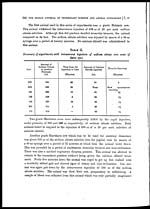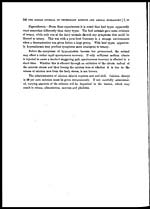Medicine - Veterinary > Veterinary colleges and laboratories > Indian journal of veterinary science and animal husbandry > Volume 1, 1931 > Part IV (December 1931) > Artificially induced hypoglycemia and hypocalcemia in the cow and the relationship to parturient paresis or milk fever (with one figure)
(392) Page 345
Download files
Individual page:
Thumbnail gallery: Grid view | List view

HYPOGLYCEMIA AND HYPOCALCEMIA IN COW 345
in 40 minutes. Smears of this blood showed crenated red blood cells and anisocy-
tosis.
Another cow, a grade Shorthorn was given 500 cc of sodium citrate solution
over a period of 20 minutes, at which time the animal went down. She showed
muscular tremors, although the expiratory dyspnea was absent. In one and one-
half minutes after the animal went down, 120 cc of a 20 per cent. solution of
calcium chlorid was injected intravenously and in three minutes the symptoms
produced by the sodium citrate had entirely disappeared.
The next animal, a grade Shorthorn cow, was injected with 360 cc of the
sodium citrate solution intravenously and in three and one-half minutes the animal
was down. She made attempts to rise but there was a lack of co-ordination. The
pupils were greatly dilated, there was a marked expiratory dyspnea and the act
of breathing was accomplished with considerable noise. Nine minutes after the
animal went down, 60 cc of calcium chlorid solution was administered intraven-
ously. The pupils immediately constricted down to normal, the dyspnea and
noise of breathing ceased and all the symptoms produced by the injection of the
sodium citrate disappeared at once.
The next subject was considerably more of a dairy type than were the preced-
ing animals. This cow received 420 cc of sodium citrate solution intravenously
over a period of seven minutes, which caused the animal to go down. This cow
did not show the muscular tremors of the previous cases, although a marked expi-
ratory dyspnea was present. The condition in this case more closely simulated
that found in milk fever cases. There was present the comatose condition so
characteristic of milk fever. After the animal had been in this condition for
twenty minutes, 100 cc of calcium chlorid solution was administered by intraven-
ous injection. The respiratory symptoms disappeared at once, although the coma
persisted. Sixty cc more of the calcium chlorid solution was given and in five
minutes the animal got up on its feet, and at first was unsteady but, after taking a
few steps, appeared apparently normal.
DISCUSSION AND CONCLUSIONS.
Hypoglycemia.—The data presented bring out two important considerations.
1. Hypoglycemia is not analogous to milk fever symptoms.
2. The bovine tolerates a much lower blood-sugar level than is reported for
other species,
The rather prolonged cases of hypoglycemia, going as low as 17 mg. per 100 cc
in trial II, should dispel any question as to low blood-sugar being a cause of partu-
rient paresis.
Set display mode to: Large image | Zoom image | Transcription
Images and transcriptions on this page, including medium image downloads, may be used under the Creative Commons Attribution 4.0 International Licence unless otherwise stated. ![]()
| Permanent URL | https://digital.nls.uk/75226971 |
|---|
| Description | Covers articles from 1931. |
|---|




